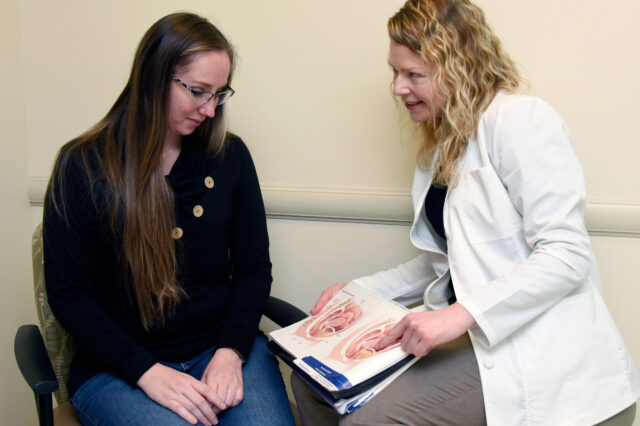Pelvic organ prolapse is most often seen in older adults. The condition occurs when the support structures that hold the pelvic organs — the bladder, uterus, vagina and bowel — become weakened and allow the pelvic organs to drop or bulge into the vagina.
Pelvic organ prolapse: Your care team
At UF Health Jacksonville, we can help. Our compassionate and accomplished physicians who specialize in Urogynecology and Reconstructive Pelvic Surgery will provide a comfortable environment for discussion and offer you successful treatment options to improve your quality of life. They also have access to other hospital specialists as needed to find the best possible solution for you.
Pelvic organ prolapse: Causes
- Childbirth: Pregnancy and childbirth can damage pelvic organ support structures.
- Menopause: Changes due to aging and the loss of estrogen with menopause, can weaken the support to the pelvic organs.
- Excessive pressure on the pelvic floor: Conditions such as obesity, chronic cough, constipation, straining, and picking up heavy items on a repeated basis can weaken the support to the pelvic organs.
- Genetics: The strength of connective tissue can be determined by the genes. If your mother or sister have pelvic organ prolapse, then you may have a higher risk of developing pelvic organ prolapse. Diseases such as Marfan syndrome, Ehlers-Danlos syndrome affect the strength of connective tissue and can be risk factors for prolapse.
Pelvic organ prolapse: Types
- Anterior vaginal wall prolapse (cystocele): The front wall of the vagina sags allowing the bladder and the urethra to drop from their normal positions and slide toward the vaginal opening.
- Posterior vaginal wall prolapse (rectocele): The back wall of the vagina sags, which results in the rectum bulging upward toward the vaginal opening.
- Uterine prolapse: The supports to the uterus and upper vagina weaken letting the uterus slide toward the vaginal opening.
- Vaginal vault prolapse: For women who’ve had a hysterectomy, the upper support of the vagina weakens, and the upper vagina is able to sag toward the vaginal opening.
- Enterocele: The upper vagina sags permitting the small intestines to slide down toward the vaginal opening.
Pelvic organ prolapse: Symptoms
- Feeling a bulge, a lump, extra vaginal tissue, or pressure at the vaginal opening.
- Urinary symptoms such as a weaker urine stream, difficulty emptying, increased urinary frequency, and increased urinary urgency
- Bowel symptoms such as difficulty with bowel movements, a feeling of not completely emptying, or needing to push on the vaginal walls to empty
Pelvic organ prolapse: Treatments
Treatment options vary depending on the type of pelvic organ prolapse. Here are a few your physician may discuss with you:
- Lifestyle changes, such as eating more fiber or taking stool softeners can ease the strain on pelvic muscles
- Physical therapy, with the aid of experienced UF Health physical therapists, to help strengthen pelvic floor muscles
- Treatment options for urinary or fecal incontinence that may result of pelvic organ prolapse
- Medication to help improve bowel function
- Minimally invasive and robotic surgery to correct many types of pelvic organ prolapse


